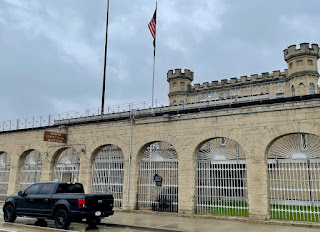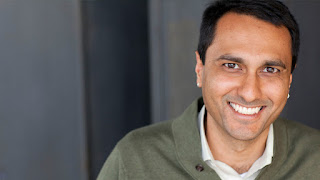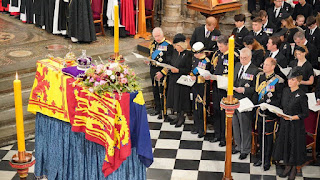Nov. 27, 2022, Christ Presbyterian Church
Luke 21:25-36
You can hear this sermon here on YouTube.
Pastor Jessica likes to describe the reading we are about to hear as the one for “Scary Advent.” And lucky me – I get to be the one to preach this Sunday.
In this passage from the Gospel according to Luke, you will hear things that sound pretty ominous – or just plain confusing.
Just before this passage, Jesus had been teaching in the Temple in Jerusalem. The chief priests and scribes and elders came to challenge him. They began to plot how to capture Jesus and turn him over to the Roman authorities.
Right after this reading, we move toward the Last Supper, the betrayal of Jesus, his execution.
We think of Advent as a time to remember Jesus’ birth, his entry into our world. But this reading does not look back to that moment. It looks forward to a time when God’s vision for the world becomes a reality, even after all the troubles that are so much a part of lives in every generation.
These words might be hard to hear at first in this season, but think of them as Jesus’ signs of hope in the midst of suffering.
Luke 21:25-36 (NRSV Updated Edition)
“There will be signs in the sun, the moon, and the stars and on the earth distress among nations confused by the roaring of the sea and the waves. People will faint from fear and foreboding of what is coming upon the world, for the powers of the heavens will be shaken. Then they will see ‘the Son of Man coming in a cloud’ with power and great glory. Now when these things begin to take place, stand up and raise your heads, because your redemption is drawing near.”
Then he told them a parable: “Look at the fig tree and all the trees; 30 as soon as they sprout leaves you can see for yourselves and know that summer is already near. So also, when you see these things taking place, you know that the kingdom of God is near. Truly I tell you, this generation will not pass away until all things have taken place. Heaven and earth will pass away, but my words will not pass away.
“Be on guard so that your hearts are not weighed down with dissipation and drunkenness and the worries of this life and that day does not catch you unexpectedly, like a trap. For it will come upon all who live on the face of the whole earth. Be alert at all times, praying that you may have the strength to escape all these things that will take place and to stand before the Son of Man.”
+++++++++++++++++++++++++++++++++++
Jesus was not painting a pretty picture here. “Signs in the sun, the moon, and the stars and on the earth distress among nations confused by the roaring of the sea and the waves. People will faint from fear and foreboding of what is coming upon the world, for the powers of the heavens will be shaken.”
There is both beauty and chaos in this picture – much like we hear from Jesus, words that ultimately can give us hope in our own chaotic times. We’ll come back to that later.
When the Gospel according to Luke was written, it was probably late in the first century, after Rome had conquered Jerusalem and destroyed the Temple – the very Temple where Jesus had been speaking in this passage from Luke.
In some places, the Romans were persecuting the followers of Jesus. For the Jewish people – and for the many followers of Jesus who were of Jewish heritage and those facing persecution for being part of this new religious sect – this must have been a time when it felt like their world was coming to an end.
I think sometimes – 2,000 years later – it can feel that way to us as well.
Roaring seas and waves. They are not new, but climate change has made them ever more intense, along with raging forest fires and deep droughts.
Fainting from fear. Just in the past few months, we have witnessed a continuing spate of mass murders – in a Wal-Mart in Virginia, at an LGBTQ nightclub in Colorado, at a food court in a mall in Indiana, at a Fourth of July parade in Illinois.
Foreboding of what is coming. The people of Ukraine know that feeling well as Russian missiles cut off their energy supply as winter settles in. So do people in so many other places where starvation looms. So do people in this nation, divided by ancient racial animosities, split by political polarization.
It made the people in Jesus’ time, it makes people in our time, want to cry out for rescue.
There’s a familiar song that captures a bit of that feeling.
There are so many of these songs that emerged from enslaved people in our nation, spirituals about the longing to be home. They were also songs about longing for freedom. Those songs will be our companions this Advent.
Let’s sing just the chorus of Swing Low. I’ll start with “Swing low, sweet chariot,” and then you answer “Coming for to carry me home.”
Swing low, sweet chariot.
Coming for to carry me home.
Swing low, sweet chariot.
Coming for to carry me home.
The first verse says:
“I looked over Jordan, and what did I see,
Coming for to carry me home?
A band of angels coming after me.
Coming for to carry me home.”
Yes, the Jordan River. That same Jordan River where Elijah was carried away. And for some of the enslaved people of the U.S., the Ohio River came to represent the Jordan – a place they could cross on the underground railroad to freedom.
This painting from 1944 by the noted African American artist William H. Johnson, captures the chariot, the river and the band of angels greeting someone heading to freedom.
So home, in this song, is not only a reference to heaven. It is also a reference to freedom.
Luke Powery, the dean of the Duke University Chapel, has done a lot of work connecting the spirituals to this season of Advent. His book, Rise Up Shepherds, is one of the reading suggestions we are offering for this season. There will be two Bible study groups – one on Tuesday noon, the other on Thursday noon – that will use a series he has prepared exploring the four spirituals that will appear in worship today and for the next three Sundays.
In that book, Powery writes of Swing Low: “Home is where we will be free. God wants us to be free. God wants us to find our home in him, the One who is our refuge and strength, our strong tower. Come home, not to your neighborhood, but to the abiding, loving presence of God.”
Swing low, sweet chariot.
Coming for to carry me home.
Swing low, sweet chariot.
Coming for to carry me home.
That brings us back to Jesus’ words in the Gospel according to Luke.
In the midst of all the scary things around you, Jesus says, “stand up and raise your heads, because your redemption is drawing near.”
Redemption. We will be set free. The love of God shown to us in Jesus will set us free. In the midst of all the chaos, watch for the Son of Man – a name for the one who will mark the end of this life as we know it and bring us to the time of God's judgement. Jesus adopts that identify for himself.
Redemption thus equals liberation. God’s judgment is more than a personal evaluation of our lives. It brings liberation from the fallen world and its corruption that too often seems to swirl around us. It is rescuing people from the systems that oppress them.
Then there is the fig tree. How did that show up in the middle of this rather apocalyptic speech by Jesus?
“Look at the fig tree and all the trees; as soon as they sprout leaves you can see for yourselves and know that summer is already near. So also, when you see these things taking place, you know that the kingdom of God is near.”
The fig tree is often used as a metaphor for the peace and prosperity of Israel in the Hebrew scriptures. Once you know that, you know that this little interlude is a moment of hope. It’s not just destruction and chaos that are signs of God breaking through. It’s also new leaves on the fig tree that suggest that God’s vision for the world is getting closer to reality.
So, Jesus, says, don’t let your hearts be “weighed down with dissipation and drunkenness and the worries of this life.” OK – so ease up on the partying. Also, let go of some of that anxiety.
More importantly, says Jesus, “Be alert at all times, praying that you may have the strength to escape all these things that will take place and to stand before the Son of Man.”
There’s that contradiction again with what we tend to think about Advent. It is a time of waiting. And Jesus says be ready right now.
It was Luke, after all, who wrote the best known story of Jesus’ birth. Now it is Luke recounting the story of Jesus near the end of his life not looking back nostalgically at the songs of angels, the gathering of shepherds, the presents from wise visitors. No, Jesus is looking forward on our behalf, offering not just words of warning, but words of encouragement that if we keep our focus on him, we will be okay in the end.
Sometimes these kind of apocalyptic words from Jesus are talked about as an anticipation of what is called Jesus’ Second Coming. One of the great New Testament scholars of our time – N.T. Wright – likes the phrase the “reappearing of Jesus” better. That’s a phrase that was used by the early Christians, he notes.
He put it this way in his book, Simply Christian: Why Christianity Makes Sense - "He is, at the moment, present with us, but hidden behind that invisible veil which keeps heaven and earth apart, and which we pierce in those moments, such as prayer, the sacraments, the reading of scriptures, and our work with the poor, when the veil seems particularly thin. But one day the veil will be lifted; earth and heaven will be one.”
So even though Jesus is on the precipice of his own torment that will lead to his death, his message still is filled with hope. Here’s a paraphrase I read: “The world is a scary place, but don’t let your hearts be troubled by it. I have overcome the world.”
Van Gogh painted this when in 1889 he was in an asylum, plunged into a deep depression, feeling suicidal. The village at the bottom of the paining is dark. The sky is chaotic, yet the colors are bright.
Look at the movement from the brightness of the sky to the cypress trees and the hills down to the stark village where a church spire stretches up to the sky. One interpretation of this – in the midst of his own chaos, Van Gogh was bringing the divine to the village.
I think that captures what Jesus was telling the people in the Temple that day. Yes, things can be scary. Yes, there will be hard times.
In the midst of that chaos, though, there can be hope. That hope can be found when you stay connected to me, when you stay connected to God, when you let the energy of love flow from God through you to those you encounter along the way.
We don’t do this alone. We need God, we need each other. The second verse of Swing Low reminds us of that:
“If you get there, before I do…Tell all my friends I am coming too.”
So let’s end with Swing Low one more time:
Swing low, sweet chariot.
Coming for to carry me home.
Swing low, sweet chariot.
Coming for to carry me home.
Amen.



















